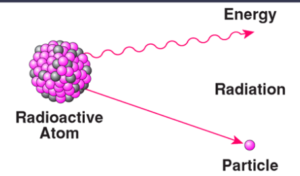Table of Contents
Half-Life, also known as Half-Life Period, is a common term used in Physics to describe the radioactive decay of a specific sample or element over a specific time period. While studying nuclear physics, students will come across the term frequently. This concept, however, is widely used to describe various types of decay processes, particularly exponential and non-exponential decay. Aside from physics, the term is used in medicine to represent the biological half-life of certain chemicals in the human body or in drugs.
In radioactivity, the interval of time required for one-half of a radioactive sample’s atomic nuclei to decay (change spontaneously into other nuclear species by emitting particles and energy), or, equivalently, the time interval required for a radioactive material’s number of disintegrations per second to decrease by one-half. For example, the radioactive isotope cobalt-60, which is used in radiotherapy, has a half-life of 5.26 years. Following that interval, a sample containing 8 g of cobalt-60 would contain only 4 g of cobalt-60 and emit half as much radiation. After another 5.26-year interval, the sample would contain only 2 g of cobalt-60. Because the unstable cobalt-60 nuclei decay into stable nickel-60 nuclei, which remain with the still-undecayed cobalt, neither the volume nor the mass of the original sample decreases visibly.

Half-Life Definition
The time required for a radioactive substance (or one-half of its atoms) to disintegrate or transform into a different substance is commonly defined as its half-life. Ernest Rutherford discovered the principle for the first time in 1907. It is commonly denoted by the symbols Ug or t1/2.
Half-lives are characteristics of various unstable atomic nuclei and the manner in which they decay. Alpha and beta decay are generally slower than gamma decay.
Beta-decay half-lives begin at one-hundredth of a second and alpha-decay half-lives begin at one-millionth of a second. Half-lives for gamma decay may be too short to measure (around 10-14 seconds), but gamma emission has a wide range of half-lives.
Half-Life Formulas
- N(t) = No (½) t / t ½
- N(t) = No e-t / r
- N(t) = Noe– λt
Probabilistic nature
The decay of discrete entities, such as radioactive atoms, is typically described by a half-life. In that case, the definition “half-life is the time required for exactly half of the entities to decay” is inapplicable. If there is only one radioactive atom and its half-life is one second, there will be no “half of an atom” left after one second. Instead, the half-life is defined in terms of probability: “Half-life is the time required on average for exactly half of the entities to decay.” To put it another way, A radioactive atom has a 50% chance of decaying within its half-life.
FAQs
What is the half-life of a radioactive substance?
The half-life of radioactive material is defined as the time required to disintegrate half of its atoms.
How long does a half-life period last?
The half-life is defined as the time required for half of the unstable nuclei to decay. The half-life of each substance varies. Carbon-10, for example, has a half-life of only 19 seconds, making it impossible for this isotope to be found in nature.







